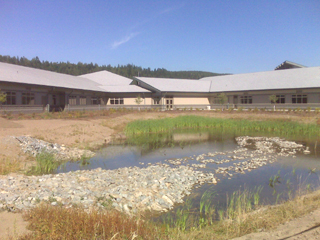
DJC.COM
August 28, 2008
Mount Rainier inspires Orting Middle School design
Erickson McGovern Architects

Zielinski
|
The new Orting Middle School is located at the base of the foothills of Mount Rainier, in a valley between the Carbon and Puyallup rivers.
One thing that takes your breath away the first time you drive into the Orting Valley is the awesome presence of the mountain, the largest glaciated volcano in the United States.
The valley was once 300 feet deeper than it is now, according to Jim Brigham, a geotechnical engineer with ERA, but once the ice age was over and the glaciers receded, Mount Rainier erupted many times, filling the valley with layers of mud, ash, trees and rocks. The deposits account for the valley’s famous fertility, but necessitated embedding 460 55-foot-tall concrete piles to support the foundation of the school.
Inspiration from glaciers

Photos courtesy of Erickson McGovern Architects “Miniature wetlands” built on the Orting Middle School campus offer teachers a living laboratory they can use to teach students about the natural world. |
Early on, the design team gained an appreciation for the deep connection between the people of Orting and the mountain whose presence dominates the landscape.
The design team went to work organizing the community of buildings that would form the school, which was oriented to take advantage of the views of the mountain. The school district wanted each of the grades at the seventh- through ninth-grade school to be located in a separate wing that radiated out from the center, where circulation and support spaces would be located, along a spine that ran all the way through the building.
The wings of the building were organized to maximize exposure to daylight and fresh air. In between the wings are two “outdoor rooms,” or courtyards, which each contain two small rain gardens and a storm pond that feeds into the natural wetlands located west of the site.
All the science classrooms are oriented toward these outdoor rooms, and teachers quickly recognized the potential of these miniature wetlands to help teach students about the natural world.
During construction, the rain gardens and storm ponds already started growing water lilies, cattails and other aquatic plants, and become home to wild waterfowl such as nesting mallards — a good indication of the health of these new wetlands, despite the noisy construction.
Early on, the separate wings needed to be identified. Since the school had become a sort of metaphor for Mount Rainier, the design team took a map of the mountain’s glaciers and laid it on top of the building and noticed that the orientation of the wings aligned with the major glaciers on the mountain’s west side. The Carbon was to the north, then, moving south, the Puyallup, Tahoma, Nisqually and the Cowlitz.
Four of the glaciers also fed major rivers, two of which ran down the sides of the valley, so it made sense to name the seventh-grade wing, which is the farthest north, the Carbon wing, and the eight-grade wing, which points toward the Puyallup River, the Puyallup wing. The ninth-grade wing was named Tahoma since it is in the middle of the community and also houses the administration and main entry to the building.
The Nisqually wing, located south of the classroom wings, houses the commons, stage and music rooms. Farthest south is the Cowlitz wing, which houses the athletic/health functions and is adjacent to the athletic fields.
Symbolic materials
The ends of the building, where the community functions are located, rise up like fingers reaching out towards the mountain, framing spectacular views from inside the building.
The design team chose materials that would symbolize the mountain, using a rough, dark gray split-faced pattern of masonry along the base, and a gradation of lighter natural colors and smoother textures as the building rises up to meet the sky.
On the interior, certain views of the mountain are framed at intersections or important nodes of the building, with views out to the wetland ecosystems in the outdoor rooms created by the wings of the buildings.
The roofs of the classroom wings are also oriented to slope down into the wetlands to shed water naturally, like the mountain sheds water into the rivers.
Mount Rainier is a powerful icon and an awesome presence in the Orting Valley, and we were fortunate to have an opportunity to give form and expression to the spirit of this place by orienting students to their unique surroundings.
Stan Zielinski is a principal with Erickson McGovern Architects in charge of design for the new Orting Middle School.
Other Stories:
- Can good design boost the case for school consolidation?
- Nature’s obstacles force fresh thinking in Everett
- Green goals guide UW’s Architecture Hall renovation
- What the future holds for school design
- UW building to get B-school students mingling
- Colleges expand to meet health care demand
- Northwest University answers call for nurses
- A science building that goes easy on energy
- The next generation of American schools
- 7 questions project managers should ask about BIM
- Tribal schools expand role preserving native cultures
- Spend more now to save big in the long run
Copyright ©2009 Seattle Daily Journal and DJC.COM.
Comments? Questions? Contact us.